Ever brushed your hand over a satiny wood surface and wondered, “What’s the secret?” Enter Danish Oil. Curious yet?
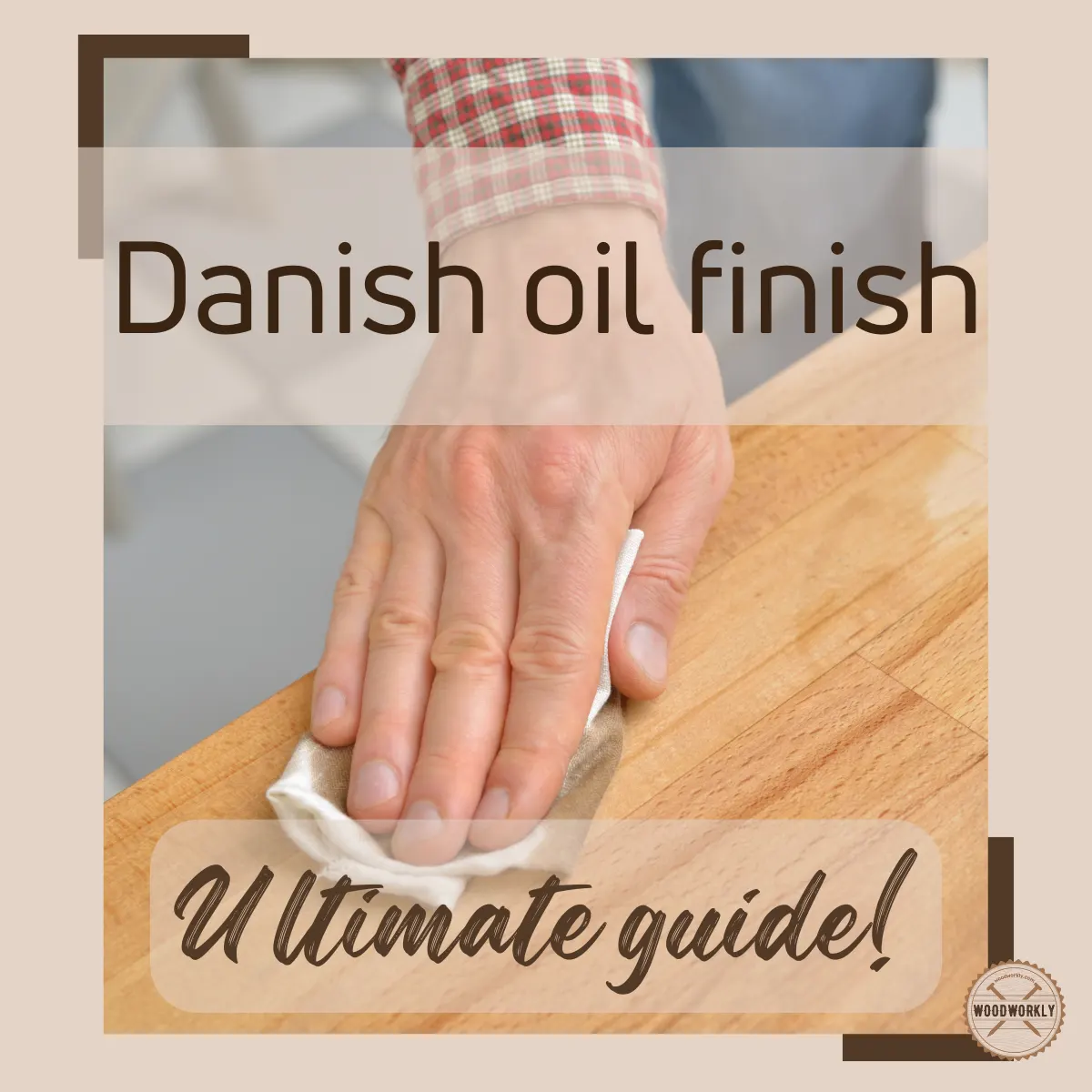
When it comes to wood finishing oils, Danish oil is hard to miss because of its excellent properties and unique features that help to protect wood furniture and other woodwork from elements and to enhance the appearance of the wood.
After working with Danish oil for more than a decade, here’s what I know and everything you need to know about Danish oil.
Danish Oil is a wood finishing blend, often derived from Tung or Boiled Linseed Oil, combined with solvents and sometimes varnish. Unlike pure natural oils, it’s a versatile mixture designed to protect, nourish, and give wood a satin finish, with variations based on brand interpretations.
Danish oil is considered one of the best finishes for any woodworking project.

There’s a lot more to know about Danish oil and how it uses as a finish.
So, in this article, I’ll explore Danish oil uses, benefits, how to apply Danish oil, the waterproofing ability of Danish oil, and everything you need to know about Danish oil.
Furthermore, I’ll answer some frequently asked questions as well.
Let’s dig in!
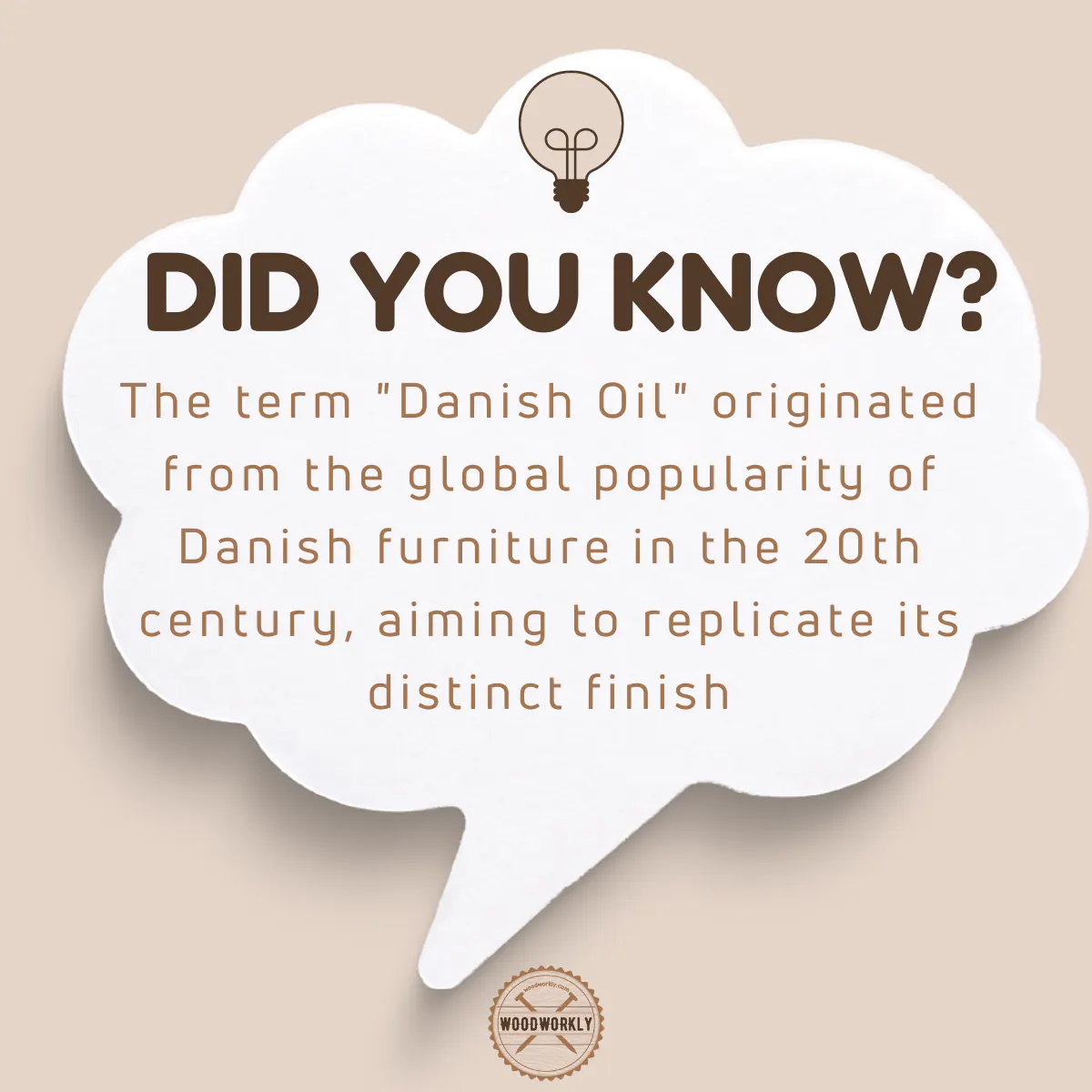
What Is Danish Oil?
Danish oil is a deep penetrating oil that is made of Finishing oil, varnish, and thinner.
The exact composition of Danish oil is hard to define because it varies among the manufacturers.
There’s no clear mixing ratio between ingredients.
The composition and ingredients of Danish oil are as follows,
- Finishing oil can be Tung oil or boiled linseed oil
- Varnish can be Exterior varnish or Polyurethane
- Thinner can be Mineral spirits or Turpentine
As you can see there’s no specific mixing ratio or composition for making Danish oil.
You can use any from finishing oil, any from varnish, and any as thinner and mix all of them to make Danish oil.
Composition and mixing ratios differ among different manufacturers.
Because of being a combination of good finishes like tung oil, linseed oil, thinner, and varnish, Danish oil is so good and brings an excellent natural finish to your woodwork.
It is literally a mixture of every finisher. Therefore, it has all the good qualities of each of those finishers.
- Finishing oil (Tung oil or boiled linseed oil) helps to enhance the natural look of the Danish oil finish and hardens upon the air.
- Varnish (Exterior varnish or Polyurethane) helps Danish oil finish to protect outdoor furniture and woodwork from moisture and chemicals.
- Thinner (Mineral spirits or Turpentine) helps Danish oil to soak better into the wood and is easy to apply.
Here’re some main specifications of Danish oil,
- Hardens upon exposure to air
- Enhance wood color
- Water-resistant
- Food safe
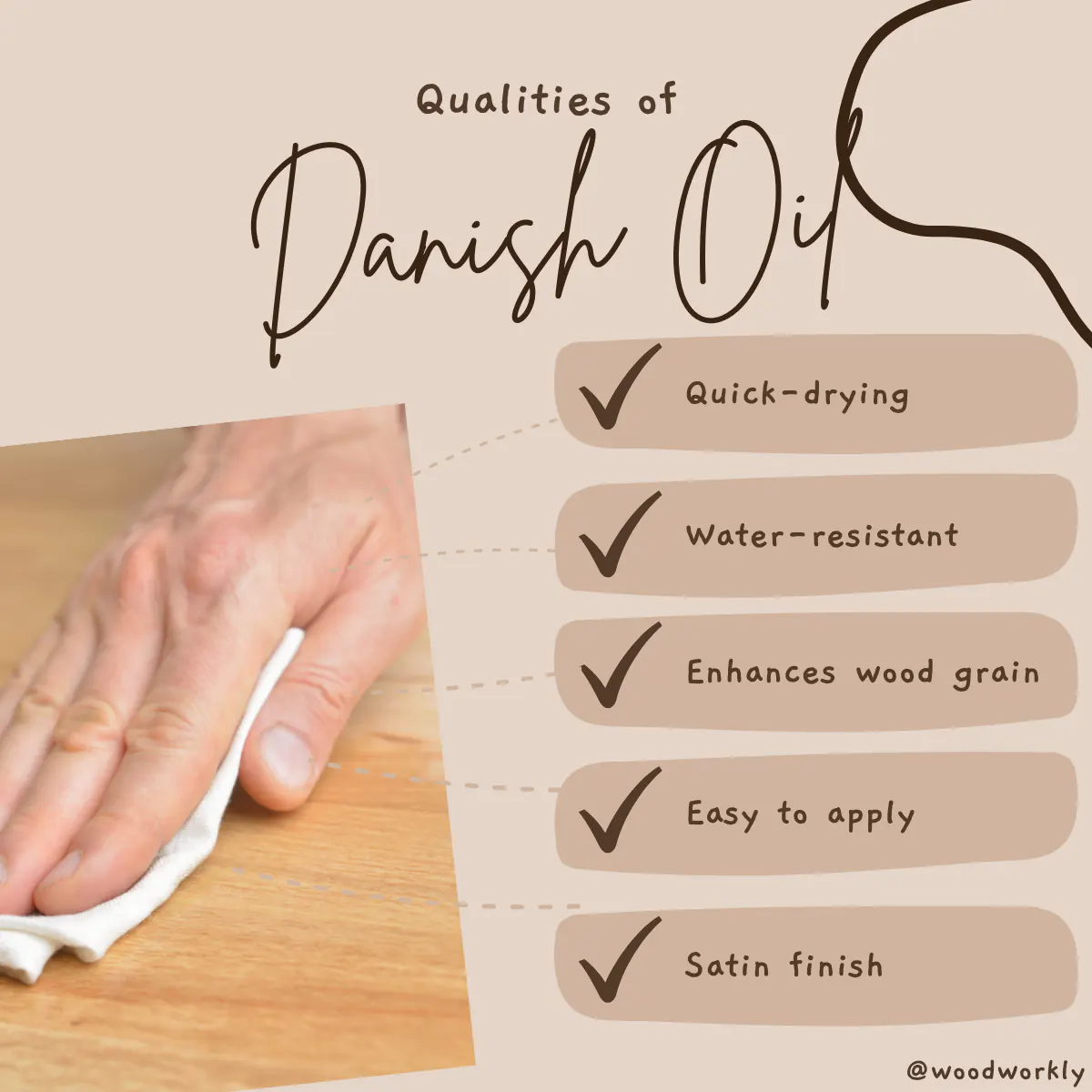
How To Make Danish Oil?
Instead of purchasing Danish oil from the market, you can make Danish oil of your own by mixing finishing oil, varnish, and thinner in equal parts.
By making Danish oil of your own, you can get the exact composition you want. Because the purposes of wood finishers differ on their application purpose.
Pick one from each category of finishing oil, varnish, and thinner and pour equal parts into a glass jar, and stir well to make Danish oil of your own.
Because each finishing oil, varnish, and thinner has different properties that serve differently with unique features.
When making Danish oil for regular use, pour 1/3 of Finishing oil, 1/3 of Varnish, and 1/3 of Thinner into a glass jar and stir.
Make sure to stir slowly without letting air bubbles trapped inside the mixture. Because trapped air bubbles make the Danish oil surface tacky and blotchy.
Here’re the compositions you need to follow when making Danish oil of your own according to the type of application.
| Application Type | Composition |
| Danish Oil for regular use | 1/3 Oil1/3 Varnish or Poly1/3 Thinner |
| Danish Oil with wear and tear protection | ¼ Oil½ Varnish or Poly¼ Thinner |
| Danish Oil with extra protection | ½ Oil¼ varnish or Poly¼ Thinner |
As you can see, apply more finishing oil to get Danish oil with extra protection which is especially helpful for outdoor applications.
When the main ingredient is oil, Danish oil gives a deep, rich natural look.
To get durable and tougher protection from Danish oil, add more poly or varnish.
This gives higher protection to your woodworks and furniture with Danish oil same as polyurethane coating.
Now you know how to make Danish oil of your won by mixing oil, poly, and thinner in a correct ratio.
But if you’re a beginner in woodworking, better to purchase Danish oil from a local store rather than making one of your own to avoid making mistakes.
Because commercial Danish oil won’t contaminate like homemade ones.
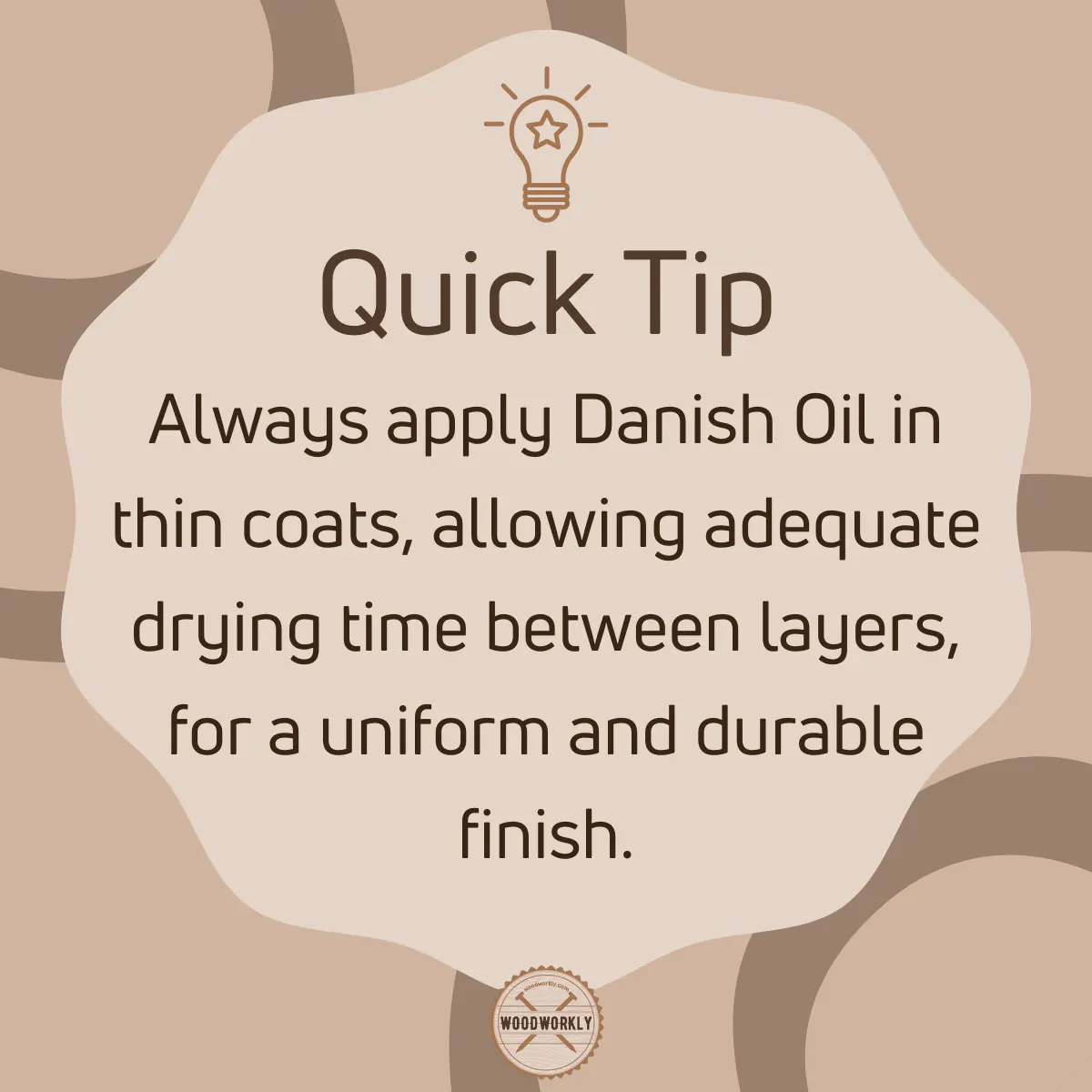
Tips To Make Danish Oil of Your Own
- Better not to use regular linseed oil since it doesn’t dry quickly as boiled linseed oil and makes the Danish oil hard to use. Therefore, always go for the boiled linseed oil to get quality Danish oil.
- If you want better moisture resistance or if you’re willing to apply Danish oil on outdoor furniture, use tung oil instead of boiled linseed oil. Because tung oil provides more water resistance than boiled linseed oil.
- For better moisture resistance, use aquatic varnish instead of polyurethane because it provides more water resistance.
- Tung oil dries slower than boiled linseed oil. You need to wait more time to apply Danish oil between coats if you use tung oil as an ingredient instead of boiled linseed oil.
- For additional protection apply, Polyurethane on top of your Danish oil coat once it is completely dried and cured after a couple of weeks.
What Does Danish Oil Do?
Danish oil provides water-resistant, hard-wearing stain and sealer. Plus, it can be used as a primer same as paint or varnish.
Therefore, Danish oil is a multi-purpose finish with lots of benefits.
Danish oil is a stain, sealer, and primer.
It can be used to improve the appearance of woodworks and furniture and also to protect the wood from moisture, peeling, and cracking.
Generally, Danish oil is considered a hard-wearing finish because it hardens quickly when exposed to the air.
When Danish oil is exposed to air, it goes through a polymerization reaction process and results in a hand-rubbed finish with an enhanced natural look.
With Danish oil, you probably won’t make any wood staining and polyurethane mistakes because it doesn’t make the surface blotchy or tacky easily.
Danish oil protects wood from moisture, cracks, insect attacks, and much more. It has become popular over woodworks because of having lots of advantages over disadvantages.
Here’s what Danish oil does in brief,
- Make protective coating
- Protects wood from cracking
- Protects wood from moisture
- Protect wood from rotting and decaying
- Resist insects and pests
- Enhance wood appearance
- Dries with no issues
- Able to apply on any wood
So, let’s find out if Danish oil is good as a wood finisher,
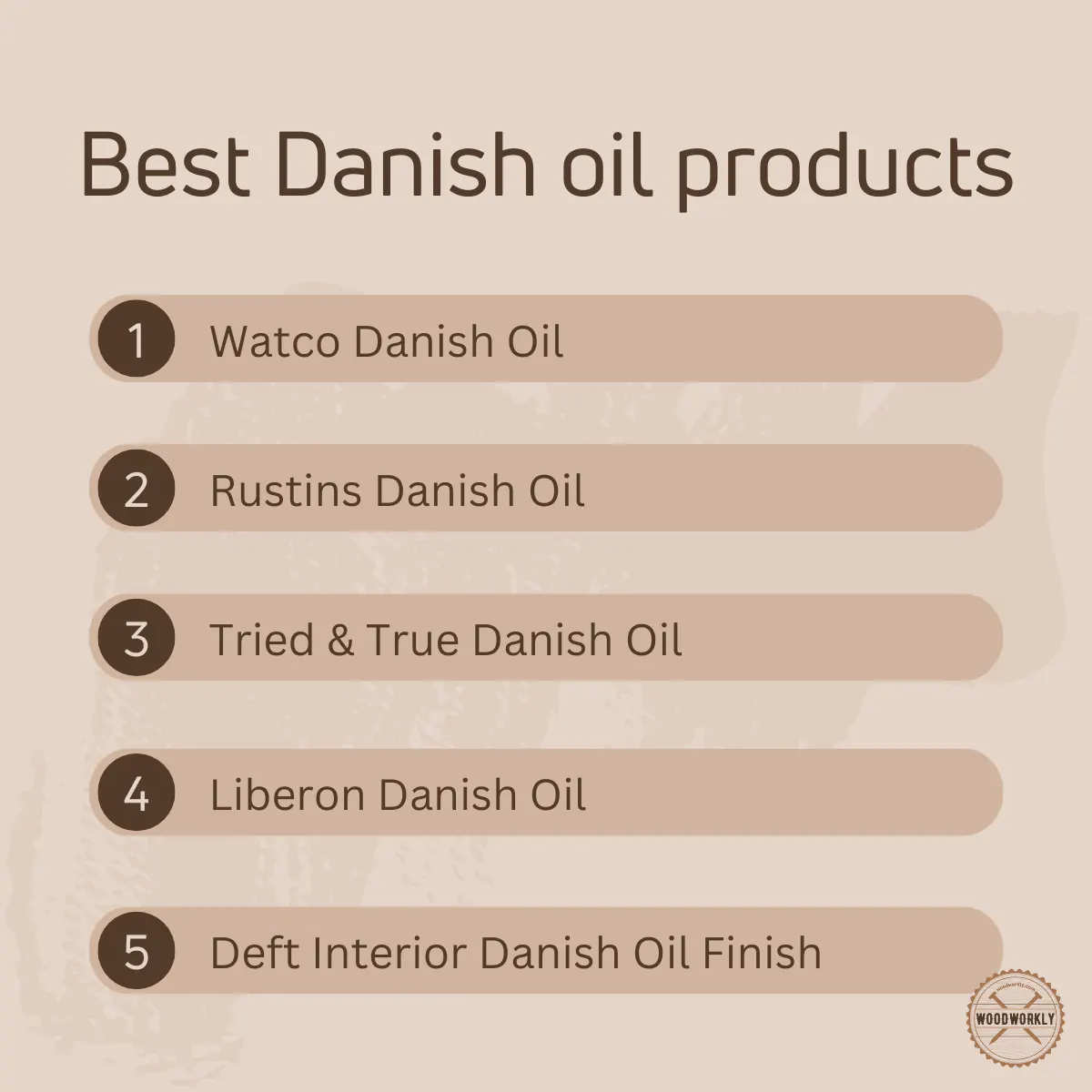
Is Danish Oil a Good Finish?
Danish oil is one of the top-grade wood finishing oils that provide water-resistant strain and seal. It gives a rich glow appearance to your food works and furniture with protection that can be improved by changing the composition as we want.
Therefore, Danish oil can be considered the best customizable finishing oil.
Danish oil is waterproof and helps to protect your furniture from environmental elements such as moisture.
Therefore, Danish oil-applied furniture can be used in both indoor and outdoor environments.
Danish oil is an excellent finish for any type of wood. it works great with both hardwoods and softwood furniture.
Danish oil finish protects wood from moisture, alcohol, and chemicals and lasts for so long.
Danish oil can have considerably higher durability than regular mineral oil and wax-based finishes.
Danish oil doesn’t rancid or mold like some other finishes. It dries faster than other oil finishes which makes the finishing process less time-consuming.
Danish oil enhances the wood appearance and gives a unique aesthetic look to your furniture. Plus, it is able to withstand harsh weather conditions as well.
Danish oil is easy to apply and provides hand rubbed finish.
You just have to wipe Danish oil on the wood surface and let it dry and cure it at room temperature. It is user-friendly and an excellent finisher for beginners as well.
Danish oil penetrates deep into the wood and enhances the natural look of the wood. once it is cured, it makes a non-oily, non-glossy, non-slippery finish with no blotches or streaks.
Because of being nontoxic after cured, Danish oil can be used to finish kitchen utensils, bowls, and spoons and also able to use for children’s toys.
Danish oil works better on untreated woods rather than treated woods because it needs room to penetrate deep into the wood to make a super protective coating.
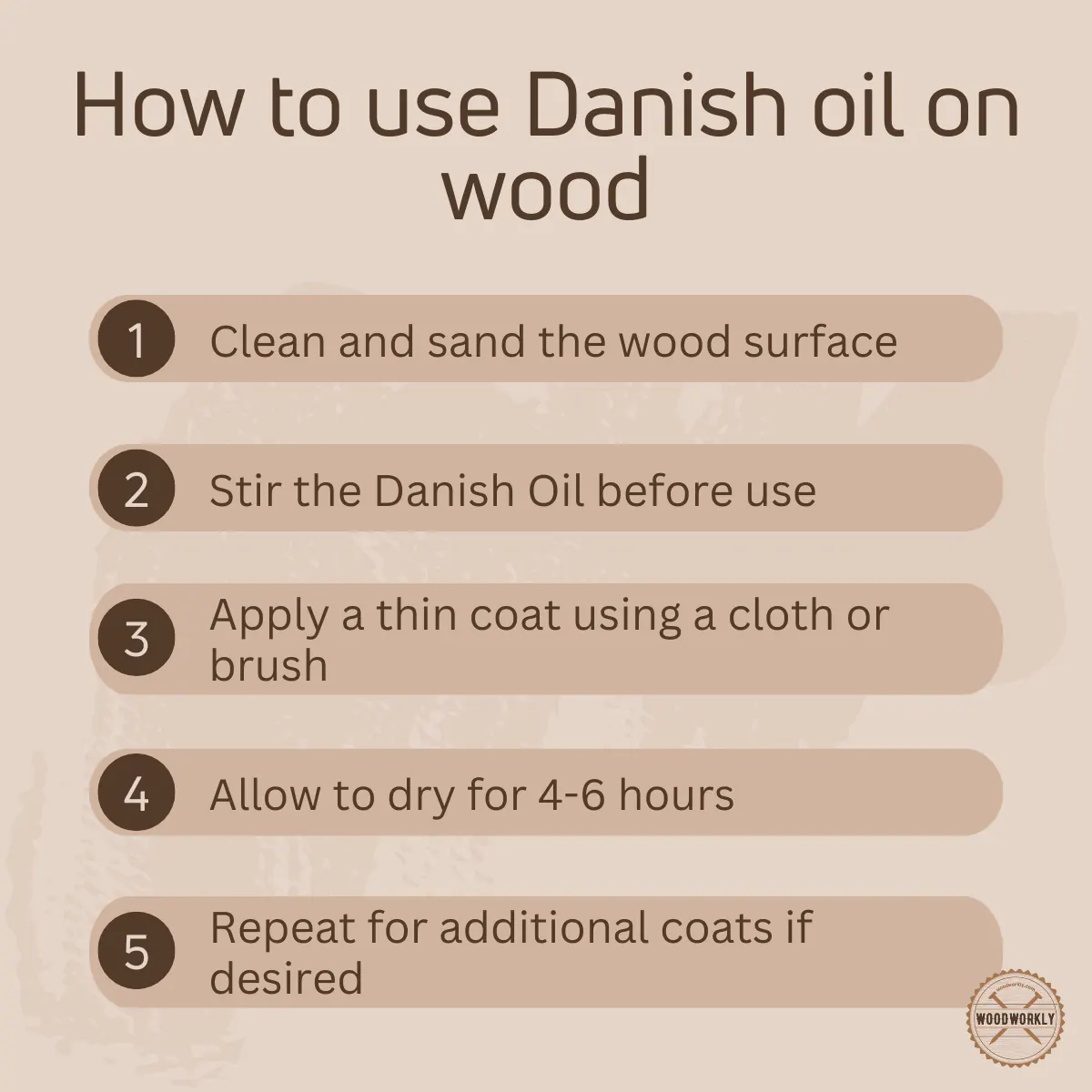
Danish Oil on Oak?
Danish oil works great on Oak. It makes a protective, natural-looking coat that enhances the natural beauty of the oak wood.
Danish oil can be applied on oak flooring, furniture, and kitchen tops to make a hard, durable finish.
Danish oil makes oak wood water-resistant and disappears scratch marks on the surface. It brings up a natural grain of oak wood.
Does Danish Oil Darken Oak?
Yes, Danish oil slightly darkens the oakwood and gives a rich enhanced look.
Danish Oil on Walnut?
Danish oil works well on walnut. It slightly darkens the walnut wood and gives a nice brown tone with enhanced wood grain.
Most people love to use Danish oil or tung oil on walnut to get a rich darker tone.
Apart from giving enhanced appearances, Danish oil protects walnut wood from moisture and other environmental elements such as UV light, insect attacks, and harsh weather conditions.
So, let’s find out supplies that are useful when using danish oil on wood.
Supplies for Using Danish oil On Wood
Here’re the supplies you need to apply Danish oil on wood,
- Danish oil
- Lint-free cloth
- Bristle brush
- Clean rag
- Sandpapers (120 grit, 150 grit, and 400 grit)
- Latex gloves
- Abrasive finishing pads
Grab the above supplies from quality manufacturers and get ready for the application process.
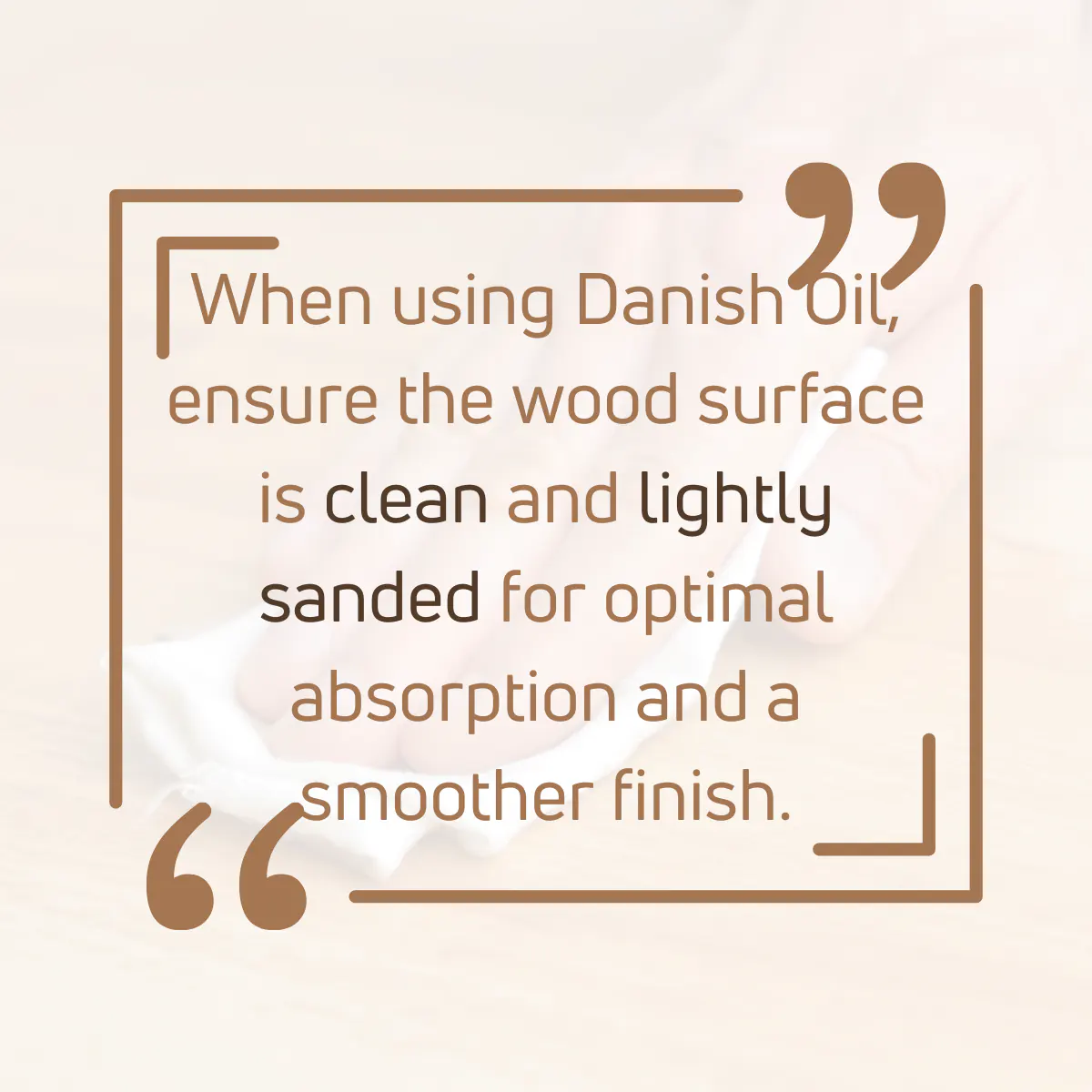
How To Apply Danish Oil?
Danish oil is easy to apply since it gives an excellent hand-rubbed finish compared to many other oil finishes. Danish oil can be applied to any interior or exterior furniture.
It is a deep penetrating finishing oil that enhances the wood grain with no issues.
There’re main two methods of applying Danish oil on any wood. they are,
- Apply Danish oil using a bristle brush
- Apply Danish oil using a lint-free cloth
Applying Danish oil with a cloth or bristle brush won’t make any difference if you follow the correct procedure.
You can control the layer thickness and fix missing spots immediately before it gets hardened.
Here’re the steps you need to follow to apply Danish oil finish on wood,
- Surface Preparation
- Apply Danish oil with a brush
- Wife off the surface
- Let it dry
- Apply the second coat of Danish oil
- Light sand the surface
- Apply more coats
- Apply poly
- Let the finish dry and cure
So, let’s discuss each of the above steps in detail to apply Danish oil well on any wood surface.
1. Surface Preparation
Clean and sand wood surface with 120, 150, and 400 grit sandpapers to make it smooth, dust, and dirt free. The remaining dust should clean with rags.
2. Apply Danish Oil with Brush
Apply the first coat of Danish oil with a brush because Danish oil soaks immediately into the wood quickly as soon as it is applied.
Therefore, even though you can apply Danish oil with a rag, I recommended using a brush to better finish with the initial coat.
Don’t worry too much about brush marks because you can wipe them up during the next steps. Apply Danish oil evenly along the wood grain without missing any spots.
Rub more oils for the areas that soaked up the oil and dry quickly. You can check this by pointing the light to the surface.
Then let the Danish oil sit and absorb to the wood surface for about 20 minutes.
3. Wipe Off the Surface
Once the first coat of Danish oil is absorbed, wipe the excess oil on the surface with clean rags. Make sure to wipe the areas with brush marks as well.
After wiping off the surface you’ll get a non-glossy surface with no sticky oil in it.
Wiping excess Danish oil is necessary to avoid getting blotchy or tacky surfaces.
4. Let It Dry for 6 Hours
Before applying another coat of Danish oil, let the previous coat dry completely from both inside and outside of the wood for a minimum of 6 hours.
But this drying can be much longer if your environmental humidity is high. applying Danish oil when the previous layer is wet can cause so many issues.
Therefore, never apply another coat until you feel ok to touch the dry surface without leaving a smear.
5. Apply Danish Oil with a Cloth
Use a lint-free cloth to apply a second coat of Danish oil. Take the soft dry lint-free cloth and pour Danish oil onto it until it gets saturated with Danish oil.
After that wipe down or scrub the entire wooden area without missing any spots.
When you’re wiping the wood with a rag, wipe along the direction of the wood grain gently for better acceptance of the wood to avoid residue from going back to the wood with the cloth.
Once you’re done with the second coat, wipe the excess oil with rags. Rub softly to avoid pulling off the previously applied Danish coat.
6. Sand the Surface Lightly
Sand the surface lightly with 400 grit sandpaper after soaking it in Danish oil with wet sanding or you can use abrasive pads.
7. Apply 3 – 5 Coats
Apply 3 – 5 coats of Danish oil following the same procedure. Make sure to dry and lightly sand between each coat.
8. Apply Poly for Additional Protection
Once the final coat of Danish is completely dry, apply poly on top of that to give additional protection to the wood. don’t add too much poly because poly makes your wood surface looks a bit oily. To keep the natural look, one coat of poly is more than enough.
9. Let the Coat Dry and Cure
Let the final coat of Danish oil dry for 6 hours and cure for 14 days before using it for anything. Letting Danish oil cure is essential to get it to a hard stabilized state and to see its final color.
Danish oil takes a minimum of 6 hours to harden.
Now you have a clear understanding of applying Danish oil without making any mistakes. These are the simplest method you can follow to apply Danish oil to any wood.
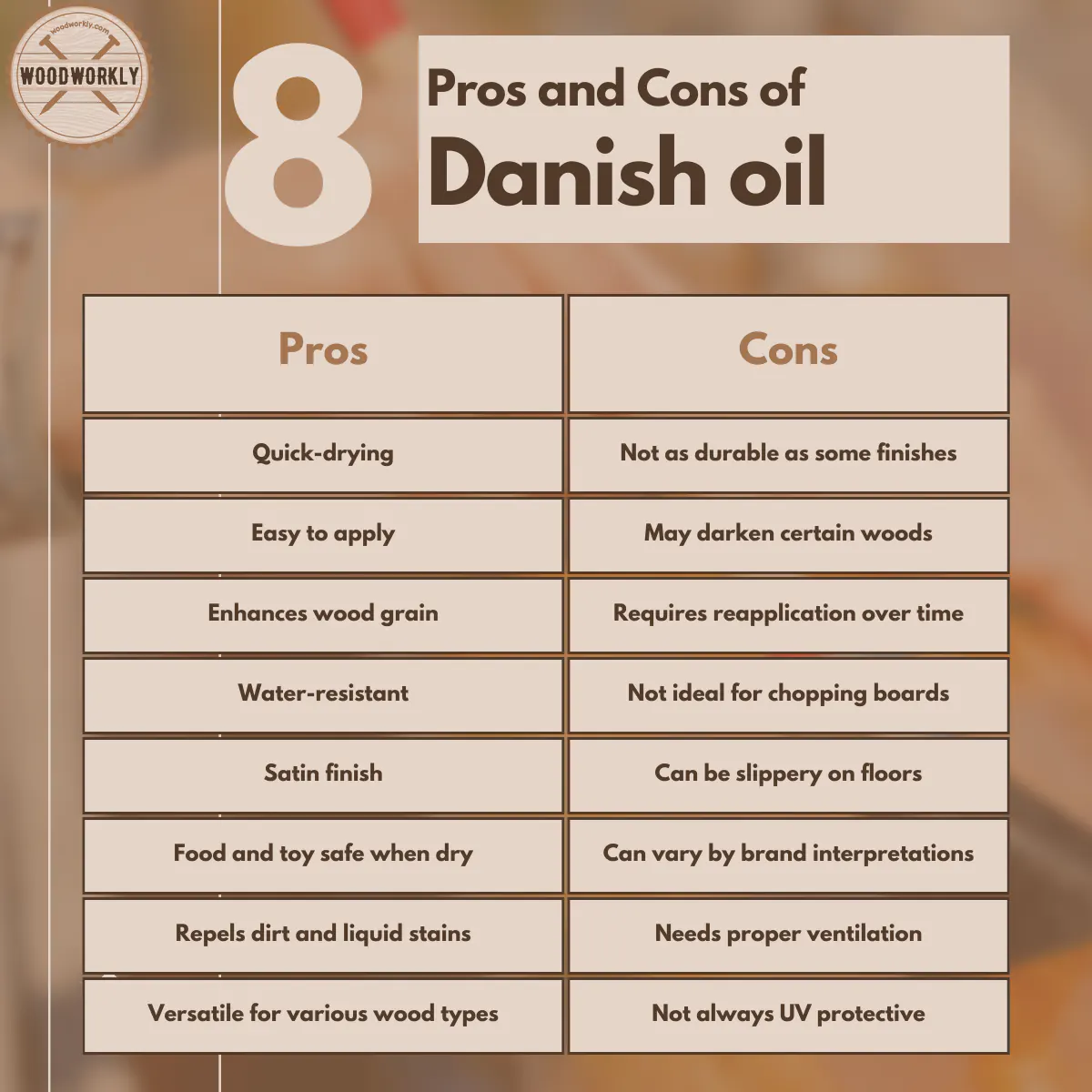
How Many Coats of Danish Oil Should You Use?
Apply a minimum of 3 coats and a maximum of 5 coats of Danish oil to get a natural-looking perfect finish with excellent protection.
But this can differ according to the wood type and type of application.
Applying more than 5 coats of Danish oil can make the surface so hard to dry and it takes a lot of time to dry and cure.
This can result in a blotchy surface.
Applying 3 – 5 coats of Danish oil is more than enough to get a non-glossy, non-slippery surface with a good protective layer against moisture, chemicals, and other elements.
How Long Does Danish Oil Last on Wood?
Danish oil lasts for around 2 years and it improves naturally for a week or two after the application.
Danish oil should apply once or twice per two years of period to keep its appurtenance and protection as it was.
With proper maintenance, the Danish oil finish can last for years. If your Danish oil finish does not get impacted by environmental elements such as moisture, direct sunlight, and insect attacks, it will easily last for a long time.
But if your Danish oil coat lives under harsh weather conditions, you’ll probably have to reapply it once every year.
Better to reapply Danish oil before the previous coating goes off completely to avoid wood getting in contact with outside moisture, because it may get rot.
Restoring rotted wood is a nightmare and you’ll have to use something like Flex Seal for that before going for the Danish oil.
Therefore, make sure to keep an eye on Danish oil-finished furniture before the previous finish fades away.
How Long Does Danish Oil Last Outside?
Danish oil lasts not more than 2 years because of climate changes, extreme temperature variations, insect attacks, UV light, moisture, and many other environmental elements.
Reapply Danish oil once per year to protect your outdoor furniture from the elements.
Apply an additional coat of poly to get extra protection. Poly coat not only protects the wood but also protects the Danish-coated layers as well.
It works as an extra shield which is so useful when it comes to outside environments.
What Is Danish Oil Finish Used For?
There’re so many different types of uses and applications of Danish oil. Because of being a combination of different finishes, Danish oil is so versatile.
It makes a protective coating over any wood with an enhanced natural appearance.
Here’re some uses of Danish oil finish,
- Wood furniture
- Window frames
- Cabinets
- Kitchen utensils
- Children’s toys
- Countertops
- Desks
- Wood carving
- Musical instruments
Make sure not to apply Danish oil on treated, stained, or painted wood.
Danish oil works great on unfinished or untreated wood since wood won’t absorb Danish oil when it is already treated.
Danish oil helps to protect wood furniture, woodwork, and wood carvings from UV light, moisture, bugs, and insects.
It prevents wood from rotting and decaying.
Yes, you read it right! You can apply Danish oil on any wood carving project to keep them safe for so long.
Is Danish Oil Finish Waterproof?
Yes, the Danish oil finish is waterproof. It has excellent resistance to water, moisture, and other liquids.
Danish oil’s protective layer avoid moisture from penetrating into the wood fibers which can cause wood rot.
Make sure to apply Danish oil without missing any spots because, once the moisture went inside, you can do nothing to do with Danish oil to stop wood from rotting.
You’ll have to go for a restoring process to remove rotted areas and repair the wood entirely.
What Is the Best Danish Oil?
Here’re some of the best Danish oil products available in local stores that can use for any wood,
- Watco Danish Oil
- Tried & True Danish Oil
- Zinsser Rust oleum Danish Oil
- Rustins Danish Oil
Congrats folks! Now you have a clear idea about what is Danish oil and how it works and its benefits as a wood finish.
Does Danish Oil Protect From UV?
Yes, Danish oil protects wood from UV light. Liberon Superior Danish oil and Watco Danish oil have UV protection that helps to protect your outdoor furniture from UV light.
But you need to see the manual because not every Danish oil protects wood from UV light, only once with UV filters.
Some Danish oils with UV filters have anti-UV pigments that absorb UV light and do not let them go through the Danish oil coating to touch the wood surface underneath.
Having UV protection in Danish oil is super useful to protect the wood from fading, discolorations, cracking, and peeling.
Does Danish Oil Darken Wood?
Yes, Danish oil darkens wood slightly and gives a rich unique look to any kind of wood. Danish oil enhances the wood grain and improves wood highlights and darkens the wood color.
Better to test Danish oil with scrap wood before heading into the main project to see how it darkens the wood color and what color will it end up with.
If you don’t want to darken the wood, better to use tung oil that gives a transparent natural finish.
Does Danish Oil Need a Topcoat?
Better to apply poly or lacquer topcoat over Danish oil to get enhanced protection from moisture, UV light, and other elements.
But you can keep Danish oil without a topcoat. applying a topcoat is optional and only necessary for outdoor use.
One coat of poly or lacquer is enough because unnecessary amounts of topcoats turn wood into an unnatural oily finish that is so hard to dry and sit on the surface.
Which Is Better Teak Oil or Danish Oil?
Teak oil and Danish oil mainly differ in their outcome. teak oil gives a matte finish while Danish oil provides a satin or semi-gloss finish.
Overall Danish oil is better than teak oil because it is more water resistant and provides resistance against wear and tear.
Teak oil is better for exterior furniture than Danish oil because most teak oil products have UV filters to protect outdoor wood furniture from UV light which can cause discoloration.
Which Is Better Danish Oil or Linseed Oil?
Danish oil is better than linseed oil because it dries faster, and Danish oil works better than linseed oil on untreated new woods.
Some Danish oil products have UV filters that help to protect outdoor furniture from UV light, but linseed oil doesn’t provide UV protection.
Even though linseed oil is an excellent finish, it’s hard to defeat Danish oil because Danish oil is a combination of lots of finishes with so many qualities and benefits.
Which Is Better Danish Oil or Tung Oil?
Danish oil is better than tung oil because usually Danish oil dries within 4 – 6 hours but tung oil takes 24 hours to dry.
Danish oil has some of the good properties of tung oil because tung oil is a part of the ingredient in Danish oil.
But when it comes to the environment, tung oil is better than Danish oil because of being so eco-friendly.
Tung oil is 100% natural and does not darken wood as Danish oil does.
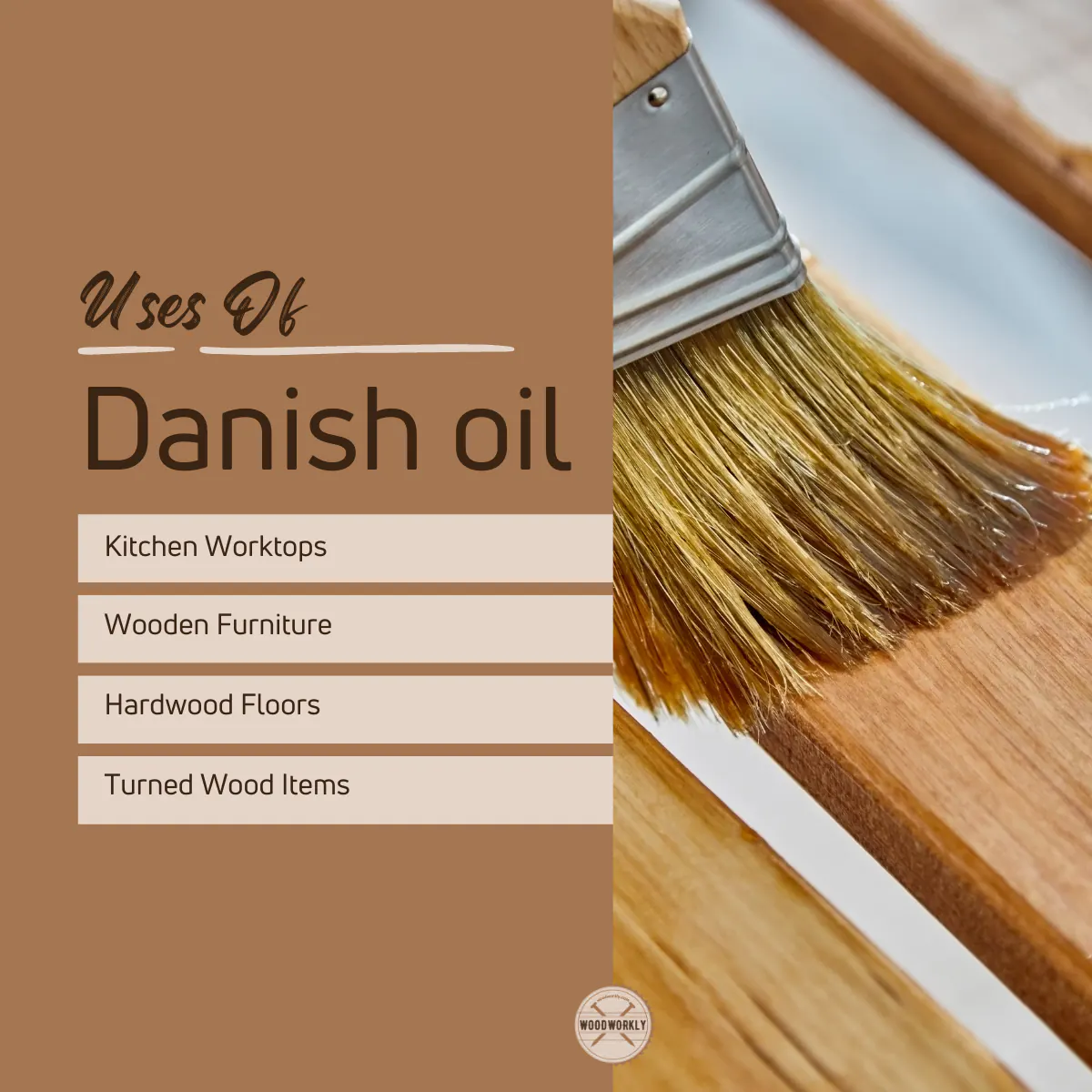
So, let’s answer some frequently asked questions about Danish oil.
FAQs
Why do people prefer Danish Oil for wood finishing?
Danish Oil offers an easy application process and dries quickly to a satin finish, making wood resistant to dirt, liquid stains, and water.
How is Danish Oil formulated?
Commonly, it’s crafted from Tung Oil or Boiled Linseed Oil, thinned with solvents for easier application. Some brands, for added durability and a smoother touch, also incorporate a touch of varnish.
On what types of wood surfaces can Danish Oil be applied?
Danish Oil is versatile, suitable for both hardwoods and softwoods, and finds use on kitchen worktops, furniture, window frames, toys, and even floors.
Can you use Danish Oil on chopping boards?
Despite its food safety once dried, it’s advisable to use specialized Chopping Board Oil for cutting boards instead of Danish Oil.
How long does Danish Oil take to dry?
Generally, Danish Oil dries in about 4-6 hours, though it’s always best to refer to the product’s specific instructions.
How many coats of Danish Oil should one apply for optimal results?
For the best finish, applying three coats of Danish Oil is typically recommended.
Did I cover all you wanted to know about Danish Oil Finish?
In this article, I have deeply explored, what is Danish oil, its benefits, uses, how to apply Danish oil, and the importance of Danish oil with its pros and cons.
Danish oil is a wood finishing oil made of boiled linseed oil or tung oil with Varnish and thinner. The composition of making Danish oil defer among manufacturers. Danish oil hardens upon exposure to the air and produces a rich glow and high-quality finish that protects the wood from cracking and peeling.
Danish oil is an excellent finish for any wood. It makes a water-resistant, hard-wearing stain that gives a darker rich color to the wood and protects it from environmental elements such as moisture, UV light, and more.
Danish oil dries upon exposure to the air. Its composition varies among manufacturers.
Danish oil is a combination of all the quality wood finishes. That’s why it has become so popular among woodworkers.
Furthermore, I’ve answered some frequently asked questions as well.
Hope you have gained good knowledge about Danish oil and how Danish oil is important as a wood finish.
Make sure to try Danish oil on your next woodworking project to see the difference. Happy wood finishing!